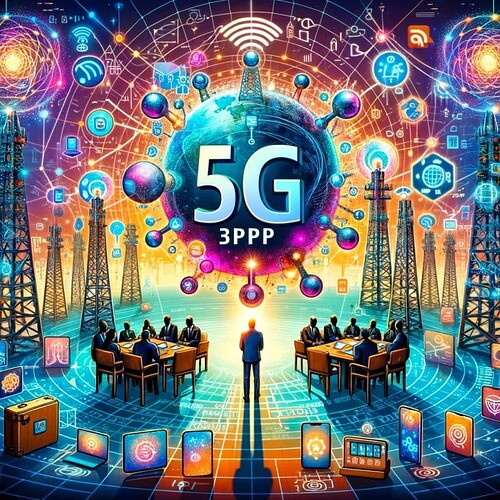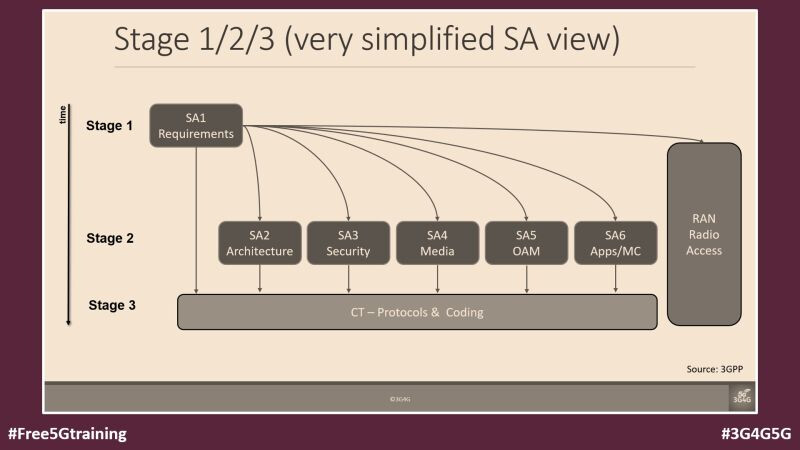3GPP Technical Specification Groups (TSGs)
 3GPP Overview:
3GPP Overview:
The 3GPP, or 3rd Generation Partnership Project, is an umbrella term for several standards organizations that develop protocols for mobile telecommunications. These organizations come together to establish unified, global specifications for mobile systems, particularly in the realm of cellular technologies like 3G, 4G, and now 5G.
2. Technical Specification Groups (TSGs):
Technical Specification Groups (TSGs):
These are specialized groups within 3GPP responsible for different aspects of mobile technology standards.
 Meetings & Leadership: TSGs hold regular meetings to discuss and approve work. They are led by a chairperson and leadership elected from the member organizations.
Meetings & Leadership: TSGs hold regular meetings to discuss and approve work. They are led by a chairperson and leadership elected from the member organizations.
 Technical Specification Groups (TSGs):
Technical Specification Groups (TSGs):
 TSG CT (Core Network & Terminals):CT WG1 focuses on the protocols between user equipment (like smartphones) and the core network. This includes how devices connect and communicate with the network.
TSG CT (Core Network & Terminals):CT WG1 focuses on the protocols between user equipment (like smartphones) and the core network. This includes how devices connect and communicate with the network.
CT WG3 deals with how the 3GPP network interfaces with external networks and manages policies and charging control mechanisms.
CT WG4 is dedicated to protocols within the core network, ensuring efficient and secure data transfer and management.
CT WG6 handles aspects related to smart card applications, which are crucial for mobile security and identity management.
 TSG RAN (Radio Access Network):RAN WG1 works on the physical layer of radio communication (Layer 1), which includes aspects like signal processing and modulation.
TSG RAN (Radio Access Network):RAN WG1 works on the physical layer of radio communication (Layer 1), which includes aspects like signal processing and modulation.
RAN WG2 handles the data link (Layer 2) and network (Layer 3) layers, focusing on resource control and allocation.
RAN WG3 is responsible for the overall architecture and interface specifications of the radio access network.
RAN WG4 addresses performance and protocol issues related to radio communication.
RAN WG5 ensures mobile terminals meet the conformance standards set by 3GPP.
 TSG SA (Service & System Aspects):SA WG1 is focused on defining services provided over the 3GPP network.
TSG SA (Service & System Aspects):SA WG1 is focused on defining services provided over the 3GPP network.
SA WG2 develops the overall system architecture and services, essential for network operation and interoperability.
SA WG3 emphasizes security and privacy, crucial in today’s digital age.
SA WG4 works on multimedia codecs and systems, enabling various multimedia services over mobile networks.
SA WG5 manages aspects of network management, orchestration, and charging.
SA WG6 looks at applications enabling critical communication and other applications.
 Responsibilities of TSG Leadership:
Responsibilities of TSG Leadership:
Leaders in each TSG are responsible for setting detailed timeframes and managing each release of new or updated standards.
They oversee the proposal and approval of new work items, ensuring they align with the group’s scope and objectives.
4  The 5G Standard:
The 5G Standard:
A significant focus of 3GPP is developing and refining the global standards for 5G technology. This includes defining the technical specifications for infrastructure, devices, and services that will operate on 5G networks.
LinkedIn: 
 3GPP meets four times a year at the end of each quarter to plan and develop new releases, which improve upon past releases and provide new standardized functionalities. The four releases already slated for 5G are Releases 15, 16, 17 and 18, although 3GPP may add more as technology and user needs evolve over time.
3GPP meets four times a year at the end of each quarter to plan and develop new releases, which improve upon past releases and provide new standardized functionalities. The four releases already slated for 5G are Releases 15, 16, 17 and 18, although 3GPP may add more as technology and user needs evolve over time.

